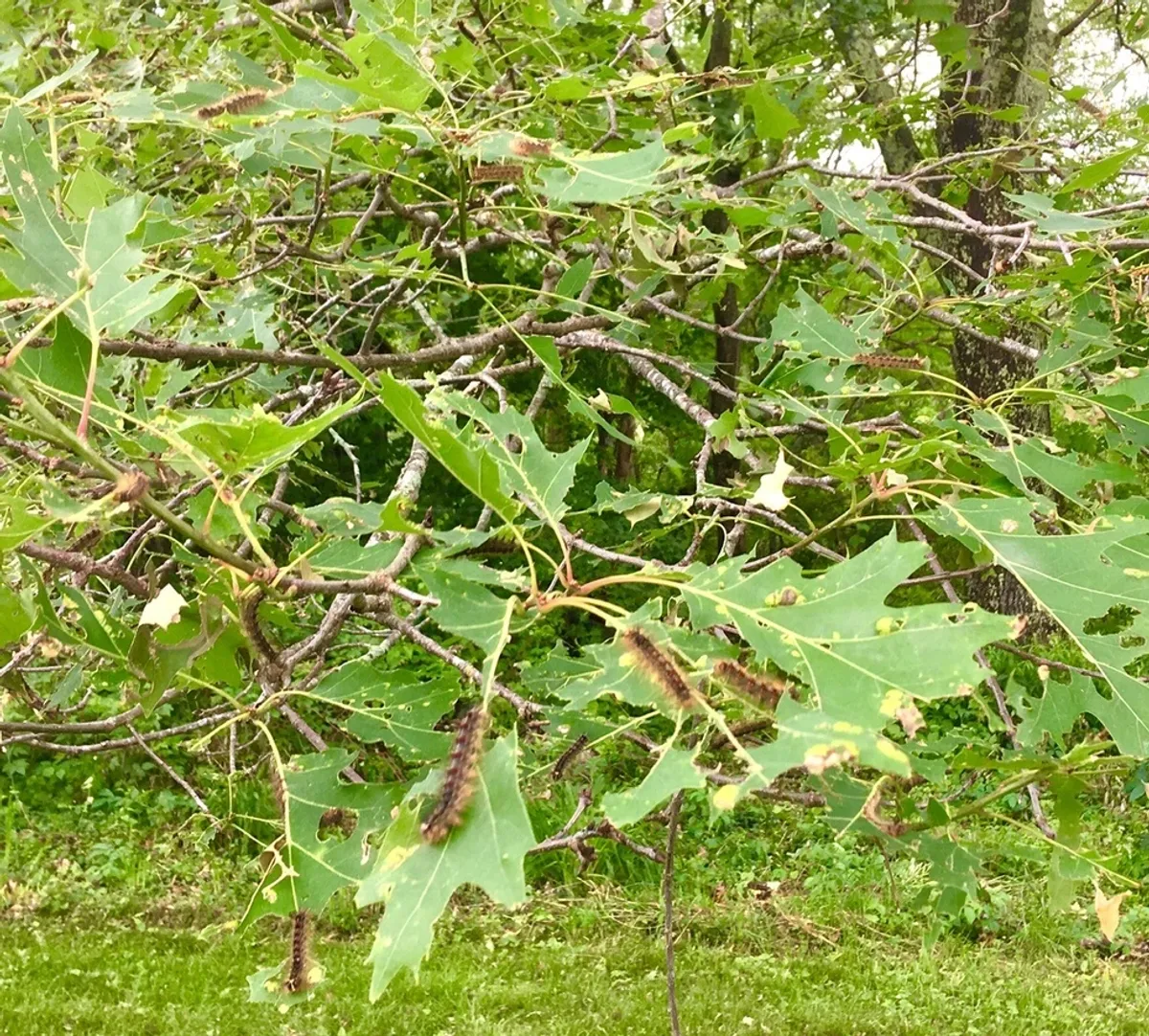What is the spongy moth, and what is it doing to our forests?

Spongy moth caterpillars have destroyed trees throughout the Tri-state region.
Peter Steiner

Spongy moth caterpillars have destroyed trees throughout the Tri-state region.
MILLBROOK — One of the major factors in the cycle of the spongy moth and their proliferation — or lack of proliferation — turns out to be acorns.
Spongy moths, formerly referred to as Gypsy moths for their itinerant ways, were the topic of a lecture Thursday, Jan. 11, by scientists Clive Jones, who has studied the spongy moth for 30 years, and Charles Canham, who has studied northeastern forests for 40 years. Both are emeritus scientists of Cary Institute of Ecosystems Studies, which hosted the lecture.
Spongy moths, natives of Europe and Asia, came to North America in 1868 or 1869, to Medford, Massachusetts. Amateur entomologist Etienne Trouvelot believed he could crossbreed them with silkworms in an attempt to “make a hardy silkworm.”
“He got some egg masses of the spongy moth and set them on the sill of his open window. When they blew into his garden, he could not find them,” said Jones.
By 1891, there was mass defoliation in the Medford area and spongy moths were found in a 200-square-mile area. From there, they began to spread throughout the U.S. and Canada.
Alone, the spongy moth travels by ballooning on silk threads; assisted, humans unwittingly transport eggs laid on cut logs or vehicles.
The life of the spongy moth could be said to begin in July and August, when the flightless female moths emit pheromones to tell males that they’re ready to mate.
They each lay a few hundred eggs, often at the bases of trees. If the moth population is high, they lay eggs anywhere, on garden furniture or on the bumper of a car.
Then, the following May, the eggs hatch. The larvae spend May and June ballooning to new locations on silken threads. They rest under trees during the day, then go up into the tree canopy at night to feed. They prefer oaks but also eat maple, beech, apple, hickory, willow and birch trees, among others.
When the population is very dense and the competition for food is fiercer, they may eat all day and night. Once a tree is defoliated, they’ll move to the next canopy.
In late June and July, the larvae pupate — a caterpillar-to-moth metamorphosis that lasts a couple of weeks — then they emerge and breed and the cycle begins again.
Jones explained that “outbreaks” — or high densities of spongy moths — “occur about every 10 years on average, but like any average, it does not mean there will be outbreaks like clockwork.”
There are two major causes of outbreaks, he continued. One is “high female fecundity,” for example: If one moth laid 500 eggs and 250 were female, 125 of those would live to maturity and lay eggs. So, in year two, there would be 125 females laying eggs, and the third year, over 15,000 would result.
The other cause of outbreaks is the collapse of the white-footed mouse population, he said. White-footed mice eat the pupae as a part of their omnivorous diet.
At this point, we reach the subject of acorns:
“The number of mice is determined by the number of acorns the previous fall,” Jones continued, saying that if there is a moderate to large acorn crop in the fall, more mice survive the winter and begin breeding earlier in the year, in late winter or early spring. When that happens, there is an extra generation of mice, meaning more mice to eat more moth pupae.
Studies at the Cary Institute concluded that “moderate to high mouse densities keep moth populations low,” while it was found “that when the mouse population declines, the spongy moth population increases.”
However, defoliation of oaks can cause the trees to produce fewer acorns, meaning less food for the mice, meaning fewer mice the following spring, meaning more moths, and so on, until the moth population collapses again.
There are three major causes of population collapse among the moths.
One is a fungus, Entomophaga maimaiga, which kills the moth at moderate and high densities. It likes cool, wet springs and is more abundant in those conditions.
The more common cause of collapse is Nuclear Polyhedrosis Virus (NPV): When the moths are at high density, they are more stressed by the struggle to find food. Their immunity drops, they are more likely to catch the virus, and many are killed.
The third cause of moth population collapse is lack of food: When they defoliate a large area of trees and run out of food too early, they can’t mature and proceed to egg laying.
Jones said that Cary Institute scientists predict an NPV collapse in 2024: “Whether or not there’ll be a lot or a little defoliation [this year] will really depend on how fast the virus moves through the population. If it moves slowly, there’ll be complete defoliation. If it goes through fast, there’ll be incomplete defoliation.”
Canham continued the lecture by saying, “Defoliation by caterpillars is rarely a direct and immediate cause of tree mortality.”
Canham explained that this is due to “carbohydrate economy”: “Basically, photosynthesis during the growing season produces the sugars needed to produce new tissues, and the energy those tissues need for their metabolism.
“But the even more important outcome of a good growing season is the profit leftover after meeting those immediate needs, and that profit is in the form of sugars and starches that act as reserves for use next year.”
Usually, unless the tree is weakened by other factors, it will draw on its reserves to get through this defoliation and produce more leaves that same year.
An exception that Canham has observed at Cary Institute is the understory hemlocks, which don’t make as many reserves and, after a couple years of defoliation in a row, may not recover. Needle trees, DEEP has noted, can be killed if they lose more than 50% of their foliate.
Canham said he worries more about the devastating effects of the emerald ash borer, longhorn beetle, spotted lantern fly and hemlock wooly adelgid than about the spongy moth.
He said if a tree is in crisis, a way to help it is to water it to “help replenish its reserves.”
For more information or to view the lecture video, go to www.caryinstitute.org/news-insights/lecture-video/...
North East Historical Society President Ed Downey introduced historian Anthony Musso for his talk on low-cost historical sites across the Hudson Valley before the annual meeting of the historical society at the NorthEast-Millerton Library Annex on Saturday, Nov. 15.
MILLERTON — With his signature Brooklyn accent, sense of humor and wealth of knowledge, author and historian Anthony “Tony” Musso brought American Revolution history to life at the NorthEast-Millerton Library Annex in partnership with the North East Historical Society.
The talk marked Musso’s first speaking engagement at the Annex and coincided with the historical society’s annual meeting.
Musso guided attendees through an oral tour shaped by excerpts from his three-volume series, “Hidden Treasures of the Hudson Valley,” which together highlight 165 local historical sites that are rich in history and light on the wallet. Each book features 55 locations that are open to the public.
“I included places that fly under the tourists’ radar,” said Musso, addressing the crowd of more than 30 attendees. “Many of them are run by historical societies, so the added benefit is a free or nominal charge.”
His presentation began with Pawling’s Quaker Hill, where in 1740 a group of Quakers petitioned the Religious Society of Friends to build their own meeting house so they wouldn’t have to travel elsewhere to go to Sunday worship.
“It was kind of small,” Musso remarked of the original structure. “They ran into a problem within the first five years because they had so many people standing around, they couldn’t all get inside.” As a result, in 1767 the Quakers got permission to build a bigger meeting house just across the street.
“This one was a two-story structure with a wrap-around balcony where they could fit everybody inside.” Musso described an event in 1778 during a regular Sunday worship when three officers from the Continental Army came into the meeting house, sat respectfully in the back, and when the service came to a close they announced that they were going to commandeer the building.
“Nearby, George Washington led a large encampment of troops and they wanted to have this building be used as a medical hospital,” Musso said.
During the army’s occupation, the makeshift hospital was overseen by Dr. James Fallon, and many people referred to it as “Fallon’s Hospital.” Approximately 100 troops were treated there throughout its four months of winter operation.
“If you know anything about Quaker beliefs, pacifism is right at the top,” said Musso. “And although the military was not putting armament, cannons or munition in the building — it was for a humanitarian purpose — the Quakers abandoned the building as long as the army was there and found another building down the hillside.”
The Quakers also refused to provide the army with provisions, Musso said, which exacerbated harsh conditions that winter.
When the army left, the Quakers returned to the building and continued with their meetings and worship. Musso added that in 1932, the meeting house was acquired by the historical society of Quaker Hill and Pawling, and “that’s why the building is in such meticulous shape today.”
Musso went on to explain that while George Washington never stayed at encampment with his troops, he did commandeer a house for four months down the hill in the village of Pawling — the home of John Kane, who was originally a Patriot at the start of the American Revolution but switched sides and became a Loyalist.
From there, Musso expanded the tour to Westchester and Rockland counties, including the location where Benedict Arnold turned over the plans, layout and staffing for Fort Arnold to British spy John André — and the site where Andre was subsequently hanged.
As a seasoned historian, speaker and guide, Musso shared one of his tricks if he ever feels like his audience is losing interest. He brings up Hamilton the musical. “I don’t lie to people,” he jokes, “but I say, ‘I can’t prove this, but I’ve heard that some of the music from Hamilton was written here.’”
Though Musso didn’t delve into the rich history of North East’s Coleman Station during the presentation, Musso said it is one of the sites included in his books.
Musso has lived in LaGrange for 40 years, and his career has spanned decades at the post office, writing for the Poughkeepsie Journal, and authoring numerous nonfiction books. “I love the history of this area, and I’m not going to stop telling it anytime soon.”
North East Historical Society annual meeting
Other business from the North East Historical Society included acknowledgements of board members and volunteers. President Ed Downey expressed gratitude for the society’s partnership with the NorthEast-Millerton Library, noted that four members are up for re-election and shared that membership has increased by 54% over the last decade, now totaling 179 — among the highest of any historical society in Dutchess County.
Downey also highlighted ongoing digitization efforts, saying the goal is to “digitize and publish” the historic Millerton Telegram and 90 years of The Millerton News. Downey added that this is a costly project and relies heavily on donations to sustain the work.
“Once Upon a Time in America” features ten portraits by artist Katro Storm.
The Kearcher-Monsell Gallery at Housatonic Valley Regional High School in Falls Village is once again host to a wonderful student-curated exhibition. “Once Upon a Time in America,” ten portraits by New Haven artist Katro Storm, opened on Nov. 20 and will run through the end of the year.
“This is our first show of the year,” said senior student Alex Wilbur, the current head intern who oversees the student-run gallery. “I inherited the position last year from Elinor Wolgemuth. It’s been really amazing to take charge and see this through.”
Part of what became a capstone project for Wolgemuth, she left behind a comprehensive guide to help future student interns manage the gallery effectively. “Everything from who we should contact, the steps to take for everything, our donors,” Wilbur said. “It’s really extensive and it’s been a huge help.”
Art teacher Lilly Rand Barnett first met Storm a few years ago through his ICEHOUSE Project Space exhibition in Sharon, “Will It Grow in Sharon?” in which he planted cotton and tobacco as part of an exploration of ancestral heritage.
“And the plants did grow,” said Barnett. She asked Storm if her students could use them, and the resulting work became a project for that year’s Troutbeck Symposium, the annual student-led event in Amenia that uncovers little-known or under-told histories of marginalized communities, particularly BIPOC histories.
Last spring, Rand emailed to ask if Storm would consider a solo show at HVRHS. He agreed.
And just a few weeks ago, he arrived — paints, brushes and canvases in tow.
“When Katro came to start hanging everything, he took up a mini art residency in Ms. Rand’s room,” Wilbur said. “All her students were able to see his process and talk to him. It was great working with him.”
Perhaps more unexpected was his openness. “He really trusted us as curators and visionaries,” Wilbur said. “He said, ‘Do with it what you will.’”

Storm’s artistic training began at New Haven’s Educational Center for the Arts. His talent earned him a full scholarship to the Arts Institute of Boston, then Boston’s Museum School, where he painted seven oversized portraits of influential Black figures — in seven days — for his final project. Those works became the backbone of his early exhibitions, including at Howard University’s National Council for the Arts.
Storm has created several community murals like the 2009 READ Mural featuring local heroes, and several literacy and wellness murals at the Stetson Branch Library in New Haven. Today, he teaches and works, he said, “wherever I set up shop. Sometimes I go outside. Sometimes I’m on top of roofs. Wherever it is, I get the job done.”
His deep ties to education made a high school gallery an especially meaningful stop. “No one really knew who these people were except maybe John Lennon,” Storm said of the portraits in the show. “It’s really important for them to know James Baldwin and Shirley Chisholm. And now they do.”
The exhibition includes a wide list of subjects: James Baldwin, Shirley Chisholm, Redd Foxx, Jasper Johns, Marilyn Manson, William F. Buckley, Harold Hunter, John Lennon, as well as two deeply personal works — a portrait of Tracy Sherrod (“She’s a friend of mine… She had an interesting hairdo”) and a tribute to his late friend Nes Rivera. “Most of the time I choose my subjects because there are things I want to see,” Storm said.
Storm’s paintings, which he describes as “full frontal figuratism,” rely on drips, tonal shifts, and what feels like emerging depth. His process moves quickly. “It depends on how fast it needs to get done,” he said. “Sometimes I like to take the long way up the mountain. Instead of doing an outline, I just start coloring, blocking things off with light and dark until it starts to take shape.”
He’s currently in a black-and-white phase. “Right now, I’m inspired by black and white, the way I can really get contrast and depth.”
Work happens on multiple canvases at once. “Sometimes I’ll have five paintings going on at one time because I go through different moods, and then there’s the way the light hits,” he said. “It’s kind of like cooking. You’ve got a couple things going at once, a couple things cooking, and you just try to reach that deadline.”
For Wilbur, who has studied studio arts “ever since I was really young” and recently applied early decision to Vassar, the experience has been transformative. For Storm — an artist who built an early career painting seven portraits in seven days and has turned New York’s subway corridors into a makeshift museum — it has been another chance to merge artmaking with education, and to pass a torch to a new generation of curators.
Le Petit Ranch offers animal-assisted therapy and learning programs for children and seniors in Sheffield.
Le Petit Ranch, a nonprofit offering animal-assisted therapy and learning programs, opened in April at 147 Bears Den Road in Sheffield. Founded by Marjorie Borreda, the center provides programs for children, families and seniors using miniature horses, rescued greyhounds, guinea pigs and chickens.
Borreda, who moved to Sheffield with her husband, Mitch Moulton, and their two children to be closer to his family, has transformed her longtime love of animals into her career. She completed certifications in animal-assisted therapy and coaching in 2023, along with coursework in psychiatry, psychology, literacy and veterinary skills.
Le Petit Ranch operates out of two small structures next to the family’s home: a one-room schoolhouse for animal-assisted learning sessions and a compact stable for the three miniature horses, Mini Mac, Rocket and Miso. Other partner animals include two rescued Spanish greyhounds, Yayi and Ronya; four guinea pigs and a flock of chickens.
Borreda offers programs at the Scoville Library in Salisbury, at Salisbury Central School and surrounding towns to support those who benefit from non-traditional learning environments.
“Animal-assisted education partners with animals to support learning in math, reading, writing, language and physical education,” she said. One activity, equimotricité, has children lead miniature horses through obstacle courses to build autonomy, confidence and motor skills.

She also brings her greyhounds into schools for a “min vet clinic,” a workshop that turns lessons on dog biology and measuring skills into hands-on, movement-based learning. A separate dog-bite prevention workshop teaches children how to read canine body language and respond calmly.
Parents and teachers report strong results. More than 90% of parents observed greater empathy, reduced anxiety, increased self-confidence and improved communication and cooperation in their children, and every parent said animal-assisted education made school more enjoyable — with many calling it “the highlight of their week.”

Le Petit Ranch also serves seniors, including nursing home residents experiencing depression, social withdrawal or reduced physical activity. Weekly small-group sessions with animals can stimulate cognitive function and improve motor skills, balance and mobility.
Families can visit Le Petit Ranch for animal- assisted afterschool sessions, Frech immersion or family walks. She also offers programs for schools, libraries, community centers, churches, senior centers and nursing homes.
For more information, email info@lepetitranch.com, visit lepetitranch.com, follow @le.petit.ranch on Instagram or call 413-200-8081.